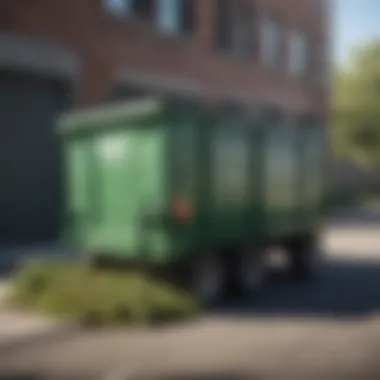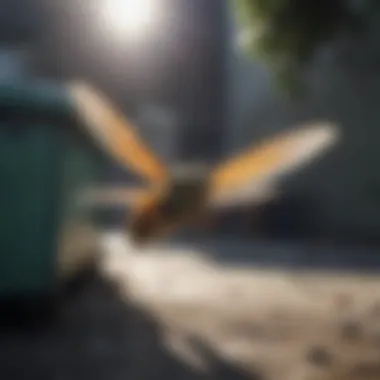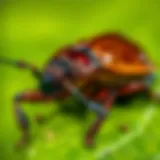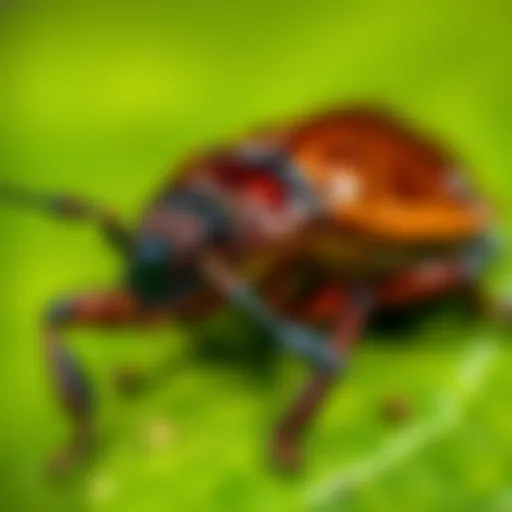Effective Strategies for Dumpster Fly Control


Intro
Managing dumpster fly infestations involves understanding the pests' behavior, biology, and optimal strategies for control. Homeowners and renters often face this problem, especially in areas with inadequate sanitation. Therefore, a well-rounded approach to dumpster fly control is essential not only for maintaining cleanliness but also for preserving the health and comfort of living spaces.
This article focuses on identifying common flies associated with dumpsters, prevention strategies to minimize their presence, and various treatment options available to handle infestations effectively.
Pest Identification
Identifying the specific flies that inhabit dumpster areas is crucial for effective control. Common pests in these environments include:
- House Flies (Musca domestica): These flies are gray, approximately ¼ inch long, with distinct green or black markings. They are attracted to decaying organic matter, making dumpsters the perfect breeding ground.
- Fruit Flies (Drosophila melanogaster): Small and tan or brown, fruit flies are often found in dumpsters with old food items. Their rapid reproductive cycle can lead to large infestations if not addressed promptly.
- Blow Flies (Calliphoridae): Characterized by their iridescent blue or green bodies, blow flies are commonly attracted to dead animals and decaying food. They lay their eggs in the waste, which can escalate the issue.
Signs of infestations include:
- The presence of adult flies around the dumpster area.
- Larvae and pupae found within or nearby the waste.
- An increase in the odor from the dumpster, indicating decomposing matter.
If you notice significant fly activity, it's essential to act swiftly to prevent further infestation.
Prevention Strategies
Prevention plays a critical role in controlling dumpster flies. Addressing potential breeding habitats can reduce the likelihood of infestations significantly:
- Home Maintenance Tips:
- Natural Deterrents and Barriers:
- Keep dumpster areas closed and tightly sealed to minimize access.
- Regularly clean dumpster interiors to remove food residues and organic matter.
- Place dumpsters away from common areas to reduce the likelihood of attracting flies.
- Use essential oils such as lavender or peppermint as natural repellents around the dumpster area.
- Create physical barriers by installing fly screens or nets on openings, securing the area against pests.
Treatment Options
Once an infestation is confirmed, it is vital to take action. Understanding the treatment options is key:
- Overview of Chemical vs. Natural Treatments:
- Step-by-Step Guides for DIY Treatments:
- Chemical treatments often include insecticides targeting the adult fly stage.
- Natural treatments can involve diatomaceous earth, which is effective in causing dehydration in flies upon contact.
- Identify the Source: Determine where the infestation is originating from in relation to the dumpster.
- Cleaning: Dispose of all organic waste and thoroughly clean the area with soap and water.
- Set Traps: Use vinegar traps for fruit flies or sticky traps for house flies.
- Apply Treatment: Utilize your choice of insecticide or natural deterrent around the dumpster area according to the product instructions.
- Monitor Regularly: Continuously check the area for new flies and promptly address any signs of returning infestations.
Understanding Dumpster Flies
Understanding dumpster flies is crucial in establishing effective pest management strategies. The presence of these flies can signal improper waste management or sanitation issues in a given area. Without knowledge of their characteristics, behavior, and contribution to the ecosystem, controlling their populations can become a challenging task.
Identification of Dumpster Flies
Proper identification of dumpster flies begins with recognizing their physical traits. These flies typically belong to the family Calliphoridae, known as blow flies, and Muscidae, which includes houseflies. The Calliphora species, for example, is prominent around decaying matter. They are characterized by their metallic blue or green hues and can range from 6 to 14 mm in length. To distinguish these flies:
- Observe their color, size, and wing position when at rest.
- Noting their behavior, especially their attraction to organic waste, can aid in identification.
- Consider using a magnifying glass for close examination if necessary.
These observations are critical for the implementation of tailored control measures.
Common Species Associated with Dumpsters
Several species are commonly found near dumpsters, contributing to pest issues. Notable ones include:
- Common Housefly (Musca domestica): This species thrives in urban environments and is often found near food waste.
- Blow Fly (Calliphora vomitoria): Attracted to decomposing material, it plays a role in waste decomposition.
- Flesh Fly (Sarcophaga spp.): These flies are known to lay eggs in decaying organic matter, including meat residues.
Understanding these species is essential since it allows for the selection of appropriate control measures that are most effective against specific types.
Life Cycle and Behavior
The life cycle of dumpster flies includes four stages: egg, larva, pupa, and adult. Females lay their eggs in organic waste, taking advantage of the nutrient-rich environment to ensure their offspring's survival. The larval stage, or maggot stage, typically lasts a week, depending on environmental conditions such as temperature and humidity.


Behaviorally, dumpster flies are attracted to strong odors. They tend to gather around waste sources and can reproduce rapidly, leading to substantial infestations if not managed properly. Understanding their life cycle and behavior provides valuable insight into how to disrupt their breeding patterns effectively.
Effective pest management relies on understanding fly behavior, enabling better preventive strategies.
By being knowledgeable about dumpster flies, homeowners can assess their situations critically and implement measures that align specifically to their needs. This understanding enriches one's approach toward controlling fly populations in a sustainable manner, ultimately improving waste management practices.
Factors Contributing to Dumpster Fly Infestations
Understanding the factors that contribute to dumpster fly infestations is vital. These flies are not just a nuisance but also a sign of deeper issues related to waste management practices. By recognizing and addressing these underlying causes, homeowners and property managers can significantly reduce fly populations and create a healthier environment.
Improper Waste Management
Improper waste management is one of the primary reasons for the proliferation of dumpster flies. When waste is not disposed of properly, it leads to a buildup of organic material that serves as a breeding ground for these flies. Common mistakes include overflowing containers, leaving waste exposed outside, and failing to secure lids tightly. Flies are drawn to the odor and moisture emanating from waste materials. Conversely, proper management practices can dramatically lower the risk of infestations. Regularly scheduled waste pickup and timely disposal of food waste are essential strategies to mitigate this problem.
- Ensure that dumpsters are emptied regularly.
- Always seal food waste in bags before disposal.
- Avoid letting garbage accumulate in and around dumpsters.
Environmental Conditions Favoring Infestations
The environment plays a crucial role in the lifecycle of dumpster flies. High temperatures and humidity can accelerate breeding rates. Warm, stagnant air around frequently used dumpsters creates ideal conditions for flies to thrive. Dark, moist areas also attract them, making some dumpsters prime targets.
Here are some key points:
- Temperature: Flies proliferate between 75°F and 90°F.
- Humidity: High humidity assists in the reproduction process.
- Location: Positioning dumpsters in shaded areas can retain moisture, making them more inviting for flies.
Common Attractants for Dumpster Flies
Several specific substances attract dumpster flies, turning ordinary waste bags into a banquet. Decomposing organic matter, especially food waste, is the most significant attractant. Additionally, animal waste or even discarded beverages can lure these pests. Moreover, the presence of sugary residues and spoiled food heightens the risk of infestations.
Key attractants include:
- Food scraps: Particularly meat and dairy products.
- Sweet residues: Such as soda cans or juice containers.
- Pet waste: Often disregarded, this can significantly contribute to fly attraction.
"Awareness of what attracts dumpster flies can lead to better disposal habits and is integral to long-term pest control strategies."
Preventive Measures for Dumpster Fly Control
Preventive measures for dumpster fly control are essential to mitigate infestations. Understanding these strategies helps homeowners and business operators maintain cleanliness and hygiene in waste management systems. A proactive approach can minimize the chances of fly infestations and not only enhance the aesthetic appeal of the surrounding areas but also safeguard public health.
Importance of Proper Waste Disposal
Proper waste disposal plays a crucial role in preventing dumpster fly problems. Waste that is not disposed of correctly can attract flies, leading to rapid infestations. Homeowners should separate waste into categories such as recyclables, compostables, and general waste. By ensuring that food scraps are well-contained and that hazardous materials are properly disposed of, you can drastically reduce the likelihood of attracting flies.
Engaging in community programs for waste management also promotes better disposal techniques. Encourage neighbours to adopt these practices as well, creating a cleaner environment for everyone. Careful sorting not only helps in managing flies but also supports recycling efforts, contributing to sustainability.
Regular Cleaning and Maintenance of Dumpsters
Regular cleaning and maintenance of dumpsters are paramount. A dirty dumpster provides an ideal breeding ground for flies. Cleaning should be performed monthly at a minimum, with more frequent attention in warmer months when flies are more active. Trash should be immediately removed, and the inside of the containers should be scrubbed to eliminate residues that attract flies.
Using disinfectants specifically designed for waste areas can be beneficial. Do not forget to clean the exterior of dumpsters as well, as spills can create an unhealthy environment. This level of attention not only deters flies but also minimizes odours, making the area more pleasant for residents.
Using Dumpster Covers and Seals
Using covers and seals on dumpsters can significantly reduce infestations. These accessories act as barriers that prevent flies from entering, thus cutting off their breeding environments. Investing in high-quality dumpster covers ensures they fit securely, preventing debris from contaminating the area.
Regular inspections of these covers and seals are necessary. Damaged covers should be replaced promptly to maintain their effectiveness. By using such preventive tools, the chances of fly infestations can be diminished, creating a more sanitary and inviting environment. Properly sealed dumpsters not only assist in fly control but also prevent foul smells, encouraging responsible waste disposal practices.
Control Strategies for Existing Infestations
When faced with dumpster fly infestations, it is crucial to implement control strategies promptly. The presence of these flies not only poses hygiene concerns but can also impact the well-being of residents in proximity to infested areas. Effective management requires an understanding of both short-term and long-term strategies. The incorporation of chemical, natural, and physical control methods can significantly reduce the fly population, while also providing lasting solutions to prevent future occurrences.
In this article, we will explore specific elements of these control strategies, outlining benefits, considerations, and practical applications for homeowners and pest control professionals alike.


Chemical Control Options
Chemical control is often considered a last resort but can be necessary for managing significant infestations. There are various products available, each formulated to target different life stages of dumpster flies. For instance, insecticides that include pyrethroids can efficiently eliminate adult flies on contact. It is important to read the labels and apply them correctly. Safety precautions should be followed to minimize risks to humans, pets, and the environment.
Some options include:
- Adulticides: These kill adult flies immediately upon contact.
- Larvicides: These target larvae, preventing their development into adults.
- Bait stations: These offer attractant laced with insecticides to lure and kill flies.
This approach can sometimes yield rapid results, but over-reliance on chemicals may lead to resistance and should be managed accordingly.
Natural Remedies and Biological Control
Natural remedies represent an eco-friendly approach to pest management. They can be effective in controlling dumpster fly populations without the adverse effects associated with chemical treatments.
Some viable options include:
- Essential oils: Oils like eucalyptus and lavender have been shown to repel flies. Spraying diluted versions around dumpster areas can help deter infestation.
- Diatomaceous earth: This natural powder can be sprinkled in and around dumpsters to damage the exoskeleton of flies, leading to their demise.
- Beneficial insects: Introducing predators like parasitoid wasps can help control fly populations biologically.
It requires consistent application, but these methods can be very effective when used as part of an integrated pest management plan.
Traps and Repellents
Traps and repellents provide alternatives to both chemical and natural approaches. By capturing or repelling flies, they significantly lower their numbers. There are different types available on the market.
Traps can include:
- Sticky traps: These are usually coated with an adhesive, grabbing flies when they land.
- Attractant traps: These use substances to lure flies and trap them inside.
Repellents can be effective when used to create a barrier around dumpsters. Some common options include:
- Ultrasonic repellents: Devices that emit sounds that disturb and repel flies.
- Natural repellents: Sprays made from vinegar or citrus can act as barriers, discouraging flies from invading.
Combining these methods with regular cleaning routines can enhance their effectiveness. Each option plays a critical role in controlling existing infestations while contributing to an overall cleaner and healthier environment.
Evaluating Effectiveness of Control Measures
Understanding how well applied strategies work against dumpster fly infestations is crucial. Evaluating the effectiveness of control measures offers insight into the actual impact of various methods, guiding improvements and adjustments. When measures are assessed, it becomes clear which techniques deliver optimal results and which might require re-evaluation.
Moreover, regular assessment of control measures allows for the adaptation of strategies based on the specific needs of the environment. This ensures sustained effectiveness over time. By doing so, homeowners and pest control professionals can utilize resources efficiently, potentially reducing costs associated with ineffective treatments.
Aspects to consider when evaluating these measures include:
- Infestation Levels: Regularly check the number of flies present, noting any fluctuations after control strategies are implemented.
- Types of Flies: Different strategies might be more effective for specific species. Documentation of species can inform targeted control efforts.
- Environmental Factors: Weather, sanitation levels, and waste composition can influence fly populations, impacting the efficacy of control measures.
The significance of monitoring and adapting strategies cannot be understated. These actions empower individuals in managing infestations effectively, contributing to overall health and hygiene.
Monitoring Fly Populations
Monitoring fly populations is an important component of evaluating control measures. Implementing a structured observation plan can help identify patterns and changes in fly activity over time. Simple tools like sticky traps can provide tangible evidence of infestation levels. Setting these traps in and around dumpster areas can help track how many flies are trapped daily.
Observational methods can include:
- Regular Inspections: Frequent checks of dumpsters and their surroundings allow for immediate identification of increases in fly populations.
- Data Collection: Keeping a log of findings helps build a history of infestation trends, making it easier to assess the success of control strategies.
- Use of Technology: Utilizing apps and digital logs can enhance data collection efforts, improving accuracy and ease of monitoring.
Adjusting Strategies Based on Observations
Adjusting strategies based on observations is essential when managing fly infestations. Once monitoring reveals trends, strategies should be evaluated for effectiveness and modified when necessary. For instance, if sticky traps show higher numbers than expected, it may indicate a need for stronger control measures or additional cleanup practices.
Several considerations may guide adjustments:
- Response to Increasing Populations: If fly counts rise, it may suggest that existing measures are insufficient. An immediate reassessment of waste management practices could be required.
- Review of Attractants: Additional potential attractants may be identified during observation. If certain types of waste consistently draw flies, it may be necessary to alter disposal practices or enhance cleaning efforts.
- Feedback Loop: Seek feedback from the individuals involved in pest management efforts. Their insights can provide valuable information on the ground.


Role of Professional Pest Control
The intricacies involved in managing dumpster fly infestations often necessitate the expertise of professional pest control services. While many homeowners may assume they can tackle the issue on their own, the reality is that infestations can be more complex than they appear. Professional pest control specialists possess specialized knowledge and tools that can effectively target and eliminate dumpster flies. These professionals understand the nuances of fly behavior, reproductive cycles, and the best strategies to eradicate them.
Often, the sheer variety of fly species lurking around dumpsters requires a detailed assessment, which is best done by an expert. Pest control professionals go beyond mere elimination; they also offer preventive solutions. Their services include diagnosing the root cause of the problem, implementing targeted treatments, and advising on waste management practices to avoid future infestations.
"Employing professionals can save time and prevent aggravation from repeated infestations."
When to Call a Professional
Recognizing when to call a pest control service is vital for effective dumpster fly management. Here are some indications:
- Severe Infestation: If you notice numerous flies buzzing around your dumpsters, it is likely time to enlist help.
- Persistent Problems: Continuous issues despite regular cleaning may indicate an underlying problem that needs professional intervention.
- Health Risks: If you are concerned about health risks associated with flies, professionals can provide immediate solutions.
In general, if you feel overwhelmed by the situation, it's best to consult with the experts. Their assessments remain instrumental in driving better outcomes than DIY attempts.
Choosing the Right Pest Control Service
Selecting an appropriate pest control service is essential. Consider the following factors while making this choice:
- Experience and Credentials: Look for companies with a proven track record in dealing with pest problems, especially flies. Check their licenses and certifications.
- Methods and Products Used: Ensure that their methods are not only effective but also environmentally friendly. Some services may use harsh chemicals that can adversely affect nearby humans or pets.
- Customer Reviews: Referencing testimonials and reviews can provide insight about the effectiveness and customer satisfaction levels of the service.
- Service Guarantees: Opt for companies that offer guarantees on their work. If flies return shortly after service, they should be willing to take remedial actions.
By considering these aspects, homeowners can make informed decisions that ultimately lead to successful dumpster fly control.
Legislation and Regulations on Waste Management
Legislation and regulations surrounding waste management play a crucial role in controlling dumpster fly populations. These legal frameworks are designed to maintain sanitary conditions in urban and rural settings alike. Enacting proper waste management laws not only helps to mitigate health hazards but also curbs the environmental impact caused by improper garbage disposal. When enforced effectively, these regulations can significantly lessen the factors that attract dumpster flies.
One important aspect of these regulations is the requirement for regular waste collection services. Many municipalities establish schedules that dictate how often waste should be picked up, thus minimizing the time trash sits in dumpsters. This reduces the likelihood that organic waste will become a breeding ground for flies. By ensuring timely removal of waste, communities can effectively manage fly populations.
Additionally, these regulations often mandate that dumpster enclosures be safe and secure. A locked enclosure not only prevents illegal dumping but also deters pests, including dumpster flies, from entering. Dumpsters must also usually have tight-fitting lids to prevent easy access to pests.
Proper legislation regarding waste disposal can lead to healthier communities and reduced pest problems.
Understanding Local Laws and Policies
Understanding local laws and policies is essential for effective waste management. Each locality may have different standards or restrictions regarding how waste is managed. For instance, some areas may have specific guidelines on how to separate recyclables from general waste. Familiarizing oneself with these regulations can promote compliance and help mitigate fly infestations.
It is also important to observe how local laws address business waste versus residential waste. Commercial properties often generate more waste, thus necessitating stricter enforcement of regulations. Homeowners should encourage businesses within their community to follow the local policies on waste disposal, as improper management can lead to dumpster fly issues that affect residents as well.
Community Involvement in Waste Management Practices
Community involvement is fundamental in fostering effective waste management practices. Engaging residents in conversations about responsible waste disposal cultivates an awareness that can translate into action. Regular community clean-up events can encourage everyone to take part in keeping their environment clean, thus reducing potential habitats for dumpster flies.
Programs aimed at educating families about the importance of proper waste disposal can also change behaviors. Schools can be a great avenue for this, ensuring that children grow up understanding the significance of cleanliness and waste management.
Successful waste management ultimately relies on collaboration. Communities that work together not only see immediate results in reduced pest numbers but also foster a sense of responsibility among residents. When local laws are supported by community efforts, the health benefits are significant, leading to environments with fewer pests and better public health overall.
Future Trends in Fly Control and Waste Management
The management of dumpster flies is an evolving field. Understanding the many changes and innovations in fly control methods is crucial for all those dealing with infestations. It allows homeowners, property managers, and pest control professionals to stay ahead of issues that may arise. Future trends in fly control and waste management offer insights into effective strategies that are not only efficient but also environmentally responsible. This section presents two key areas that highlight these trends: innovative technologies in pest management, and sustainable practices for waste reduction.
Innovative Technologies in Pest Management
The rise of technology in pest management cannot be overstated. New advancements are changing how we approach the control of dumpster flies. Some notable trends include:
- IoT Sensors: Internet of Things sensors can monitor waste areas, helping identify fly activity in real-time. These sensors provide data-driven insights, enabling targeted intervention.
- Smart Traps: Advanced traps that use pheromones or light to attract flies are becoming increasingly popular. These traps can be remotely monitored for effectiveness, reducing the need for constant on-site inspections.
- Biological Controls: The use of natural predators or competitive species also represents a growing trend. By introducing other insects, such as certain beetles, it can help keep the fly populations under control without chemicals.
These technologies offer many benefits. Improved monitoring can lead to quicker responses. Therefore, the pest management efforts now can be more controlled and less wasteful. Understanding these new methods is essential to improve overall management strategies effectively.
Sustainable Practices for Waste Reduction
Sustainability plays a significant role in future waste management practices. Reducing waste is a proactive approach to prevent dumpster fly infestations. Here are several sustainable strategies:
- Composting: By composting organic waste, homeowners can reduce the amount of waste sent to dumpsters. Composting also promotes healthy soil, which can indirectly contribute to less fly attraction.
- Recycling Programs: Encouraging participation in recycling programs minimizes landfill waste. Reducing waste volume leads to fewer attractants for flies.
- Community Initiatives: Engaging in community clean-up days can enhance awareness around waste disposal, encouraging proper practices. Community involvement helps create a stronger environment for addressing pest issues.
Sustainable practices not only address fly infestations but contribute to overall community health and hygiene.
Ultimately, both innovative technologies and sustainable practices form the backbone of future fly control strategies. These approaches can significantly lessen the attraction of dumpster flies, making neighborhoods cleaner and more livable. Homeowners and pest control services should stay informed on these trends to implement more effective control measures as part of their management practices.



